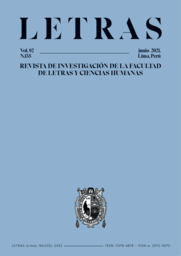El The power is nourished by dogmas. The appropriation in the work of Herman Braun-Vega
Abstract
The purpose of this article is to demonstrate, within the visual arts, the role of appropriations as a principle of articulation in the work of the Peruvian plastic artist Herman Braun-Vega, through the elements and characters taken by the artist from History of Western Art. The aesthetic and ideological proposals of the work are analyzed of the work Power is nourished by dogmas (Velásquez [sic], Huamán Poma de Ayala, El Greco) (2006). It is concluded that the appropriation of the image makes a new meaning in the work, while itis recontextualized and reinterpreted, because the appropriations in the work of this artist has the intention of make a rearticulation of the memory (individual, sociopolitical and historical). These images that are appropriations were evidenced through the visual narrative and the function of the political and religious discourse that is contained in them.Downloads
Métricas alternativas
References
Álvarez, J. (1993). El Greco. Obra completa. Madrid: Silex.
Baxandall, M. (1989). Modelos de intención. Sobre la explicación histórica de los cuadros. Madrid: Hermann Blume.
Braun-Vega, H. (2002). Herman Braun-Vega (catálogo de la Maison de l’Amérique latine y del Centro Cultural de la Pontificia Universidad Católica del Perú). Lima: Editions d’art Somogy.
Braun-Vega, H. (2003). Deja que los niños pequeños vengan a mí... (Caravaggio) [imagen]. ttps://braunvega.com/picture?/132/category/17-2003_2000
Braun-Vega, H. (2006a). El poder se nutre de dogmas (Velásquez [sic], Guamán Poma de Ayala, El Greco [imagen]. https://braunvega.com/picture?/81/category/3-2007_2004
Braun-Vega, H. (2006b). Memorias. Pinturas y dibujos 1979-2006 (catálogo de la galería en el Castillo de Valderrobres y Museo Beurbier-Rossel en Montbéliard).
Teruel: Museo de Teruel, Diputación de Teruel.
Chalumeau, J. L. (2003). La nueva Figuración. París: Cercle d’Art.
Cossío, M. B. (1908). El Greco. Madrid: Victoriano Suárez.
Crimp, D. (2005). Posiciones críticas. Ensayos sobre las políticas de arte y la identidad. Madrid: Akal.
El Greco. (1600). Cardinal Federico Niño de Guevara [imagen]. https://images.metmuseum.org/CRDImages/ep/original/DP-17777-001.jpg
Gac, R. (mayo-junio, 2003). Maestro de la interpicturalidad. Espacios Latinos, 208, 1-10.
Gombrich, E. H. (1999). La historia del arte. Buenos Aires: Sudamericana.
Goya, F. (1799). Devota Profesión, parte de la serie Los caprichos [imagen]. https://www.goyaenelprado.es/obras/ficha/goya/devota-profesion/?tx_gbgonline_pi1%5Bgocollectionids%5D=26&tx_gbgonline_pi1%5Bgosort%5D=d
Guamán Poma de Ayala, F. (1615). Nueva corónica y buen gobierno [imagen]. http://www.kb.dk/permalink/2006/poma/titlepage/es/image/?open=idp23904
Guasch, A. (2000). El arte último del siglo XX. Del posminimalismo a lo multicultural. Madrid: Alianza.
Hauser, A. (1993). Historia social de la literatura y el arte. Barcelona: Editorial Labor. Herrera Nolorve, C. y Tang-Andujar, R. (2008). Conversando con Don Herman. Nudos. Revista de arte y letras de América Latina, 1, 21-24.
Lee, L. (1992, septiembre/diciembre). Una semblanza familiar. En H. Braun-Vega, Catálogo del Antiguo Museo Español de Arte Contemporáneo (pp. 78-79). Madrid: Ministerio de Cultura.
Loaiza, H. (2001, noviembre). El sincretismo cultural en la obra de Herman Braun Vega. Resonancias Literarias y Artísticas. https://braunvega.com/picture?/554
Ortega y Gasset, J. (1987). Papeles sobre Velásquez [sic] y Goya. Madrid: Alianza Editorial.
Panofsky, E. (2004). El significado en las artes visuales. Madrid: Alianza Editorial.
Prada, J. M. (2001). La apropiación posmoderna. Arte, práctica apropiacionistas y teoría de la Posmodernidad. Madrid: Fundamentos.
Román, E. (2003, 5 de enero). Arte de Apropiación. El Comercio, p. 29.
Santa Cruz, O. (2010). Doble enfoque sobre Occidente, la influencia de Las Meninas en la obra de Herman Braun-Vega. Escritura y Pensamiento, 2 (6), 149-160.
Velásquez [sic], D. (1650). Retrato del papa Inocencio X [imagen]. https://es.wikipedia.org/wiki/Palazzo_Doria-Pamphili#/media/Archivo:Diego_Vel%C3%A1zquez_048b.jpg
Wölfflin, H. (2014). Conceptos fundamentales en la Historia del Arte. Madrid: Austral. Wachtel, N. (2017). Sociedad e ideología: ensayos de historia y antropología andinas. Lima: Instituto de Estudios Peruanos.
Zapata, A. & Rojas, R. (2008). Historia y cultura de Ayacucho. Lima: Instituto de Estudios Peruanos.
Copyright (c) 2021 Letras (Lima)

This work is licensed under a Creative Commons Attribution 4.0 International License.
Este obra está bajo una licencia de Creative Commons Reconocimiento 4.0 Internacional



















